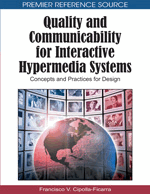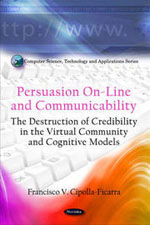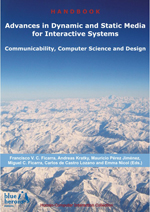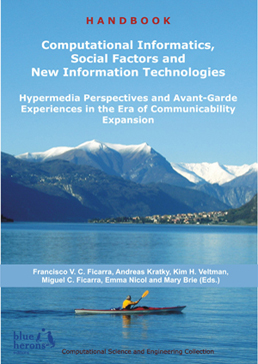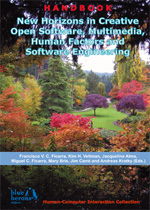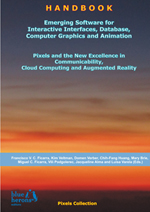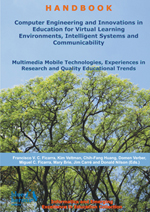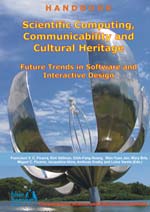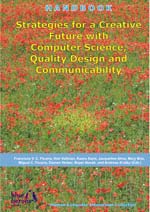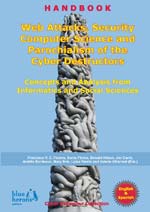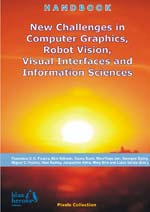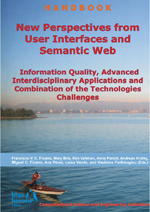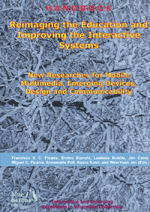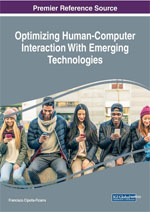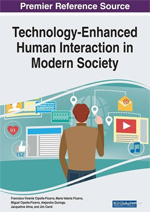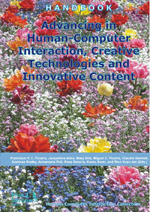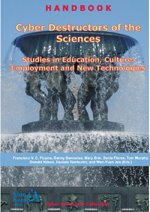Advancing in Human-Computer Interaction, Creative Technologies and Innovative Content
:: HCI Collection ::
:: Revised Selected Chapters ::
Main Editor: Francisco V. C. Ficarra
Co-editors: Jacqueline Alma (Vancouver, Canada), Mary Brie (La Valletta, Malta), Miguel C. Ficarra (Spain and Italy), Claudio Germak (Turin, Italy), Andreas Kratky (Los Angeles, USA), Annamaria Poli (Milan, Italy), Rosa Smurra (Bolonia, Italy), Kaoru Sumi (Hakodate, Japan), and Wen-Yuan Jen (Miaoli, Taiwan)
Editorial Assistants: Luisa Varela (Perpignan, France) and Donald Nilson (Oslo, Norway)
Book Details
• ISBN: 978-88-96471-50-0 :: DOI: 10.978.8896471/500
• Publisher: Blue Herons Editions
• Location: Italy (Bg)
• Subjects: 3D, HCI, Interface, Content, Interactive Systems, Design, Evaluation, Quality, UX
• Subjects: Communicability, Robot Acceptability, Human-Centred Design, Cultural Heritage
• Subjects: Computer Animation, Semiotics, Multimedia, Hardware, Robotics, GIS, AR, VR
• Subjects: Education, Cyber-Physical System, Computer Graphics, Interaction, Web DSS
• Subjects: Digital Factory, Big Data, R&D, Philosophy, Knowledge, Internet, UKM, Heuristic
• Subjects: 3D Glasses, ICT, Spin Photography, Semantic Images, Apps, Motion Detection
• Subjects: Longline Fishery, Software, Electronic Monitoring System, Maritime Traffic, IoT
• Subjects: Video Surveillance, Industry 4.0, Tourism, Photo-modeling, visTABLE, HavanApp
• Copyright: 2017
• Collection: Human-Computer Interaction
• Series volume: IV
• Publication date: December, 2017
• Binding: Paperback
• Grade level: General
• Language: English
• Illustrations: Yes
• Colour: Yes
• Pages: 236
• Dimensions: 11.41x8.26x0.7 in. 1.70 lbs. :: 290x210x18 mm. 775 gr.
Preface
No matter how long the storm is, the sun always shines again in the clouds.
Khalil Gibran (1883 – 1931)
In our days knowledge is presented as a transversal cut among different domains, fields and specialties which make up the formal and the factual sciences. The progress of the human-computer interaction, social networking and the latest technologies of information and communication make up the first triad which guide the contents of the handbook. Technologies which must be to the service of the human beings and not the reverse.
Aside from the kind of guidelines that can be drawn to get new points of intersection among the different disciplines of the formal and factual sciences, the creativitiy and communicability will always be present because since its origins it has been regarded and developed as an avant-garde area in the interactive systems, especially through the interfaces and genuine content.
This handbook aims to report advancing in human-computer interaction, communicability, creativity and user experience. Our main effort focuses on finding the common denominator between the human-computer interaction, creative technologies and original content for local and international users. That is, we address all those who are currently working to increase the quality of interactive communication of the user beings through the interactive design, new information and communiction technologies (NICT) and all their derivations, communicability and original content, wanting to know the last advances in the factual and formal sciences.
In short, that this handbook can serve as a compass to guide the current and future lines of research of the students, professors, participants in university projects, experts in technology transfer, officers responsible for the research and development (R&D), among other areas of great impact in the field of human-computer interaction and new technologies.
Besides, some contributions collected in the book have been evaluated and corrected prior to publication in an anonymous way by an international scientific committee. In some cases, said studies have been put forward orally (papers, short papers, research-in-progress, posters, etc.), with their corresponding demos, that is, accompanied with practical/theoretical cases in international conferences, workshops and symposiums such as: MSIVISM (International Conference on Multimedia, Scientific Information and Visualization for Information Systems and Metrics), SETECEC (International Conference on Software and Emerging Technologies for Education, Culture, Entertainment, and Commerce), CCGIDIS (International Symposium on Communicability, Computer Graphics and Innovative Design For Interactive Systems), HIASCIT (International Conference on Horizons for Information Architecture, Security and Cloud Intelligent Technology), HCITOCH (International Workshop on Human-Computer Interaction, Tourism and Cultural Heritage), ADNTIIC (International Conference on Advances in New Technologies, Interactive Interfaces and Communicability), HCITISI (Argentine Conference on Human-Computer Interaction, Telecommunications, Informatics and Scientific Information), RDINIDR (International Conference on Research and Development in Imaging, Nanotechnology, Industrial Design and Robotics), ESIHISE (International Conference on Evolution of the Sciences, Informatics, Human Integration and Scientific Education), and HCIHEART (International Conference on Human-Computer Interaction, High Education, Augmented Reality and Technologies). A brief summary of the chapters will be outlined below:
The authors of the chapter called “Virgil Robot at Racconigi’s Castle: a Design Challenge” are Maria Luce Lupetti, Luca Giuliano, and Claudio Germak. There is an excellent intersection between cultural heritage; service design; human-centred design; museum cultural experience; robotics; reboethics; robot acceptability, among many other topics of great impact and relevance. The project called ‘Virgil’ is explained masterfully and splendidly by its authors. In it, not only are the phases of its realization revealed, but also how the real problems within the museums have been solved for the robot's movement, the interaction with the different types of potential users, etc. The text is accompanied by photographs, diagrams, graphs, maps, etc. that promote the reading of the chapter easily and effectively for any type of audience interested in interactive design, robotics and cultural heritage, to name a few examples. Finally, it is important to note the wealth of bibliographical references in this chapter, since we are facing an unprecedented field of research, where it is easy to observe a correct synergy between various aspects of the social sciences and cutting-edge technologies, in the context of the robotics, software and system engineering, telecommunications, among others.
Rosa Smurra and Marco Orlandi are the authors of the research that has been titled “Visualizing late Victorian and Edwardian Leicester: Cultural Heritage and Education.” It is a job where history, cultural heritage, education and visualization through 3D technologies reach an exceptional level of excellence. This research work focuses on a historical period of great significance in Leicester, UK. The temporary space is the heart of 19th- and 20th-century Leicester. That is, an urban space where Victorian and Edwardian buildings, electric trams and iconic monuments, sources, etc. are reconstructed down to the minimum of their details. To such extent that it is enough to observe in the shop windows, where the products that are commercialized at that time, have been reproduced even on the labels of the different brands of objects. It is an exhaustive, detailed and progressive work, beginning with the historical analogue documentation that has been originally transferred in the 3D representation of the buildings, objects, etc. The cartography of the time and the current GIS systems also play an important role. Each one of the different sections is very well interrelated, with an evolution in the concepts in a simple and very pedagogical way.
With the title “Factory Layout optimization through Cyber-Physical System and Virtual Reality” its authors, Marko Mladineo, Nikola Banduka, and Ivan Peko, give a thorough knowledge of cyber-physical representation of a factory. In the same there is a constant interaction between subjects of special interest in the field of new technologies applied to the industry, such as: Factory layout; cyber-physical system; digital factory, and virtual reality. It is a special cyber-physical system that its authors have called Digital Factory. The main advantages obtained in transport efficiency are also presented through visualization software visTABLE. In this regard, the authors have also resorted to the use of 3D devices, such as 3D TV and 3D glasses. At the same time, the validity of the Schmigalla method for factory layout and visTABLE software has been shown. These positive aspects of the software and hardware used are explained with examples in the two case studies included in this chapter. Throughout the pages it is possible to detect the high didactic level of the authors at the moment of explaining the chosen options, in front of the different existing alternatives in the field of the new current technologies and applied to transportation.
A 'sui generis' and appropriate vision is proposed by Kim H. Veltman in its chapter called “Means of Certain Knowledge, Levels of Knowledge and Interfaces”, particularly when we are referring to issues related to interfaces, databases, access to digital information, information architecture, among many other aspects related to the conservation and safeguarding of cultural heritage, in digital format, for example. In the present work, he focuses indirectly on some of the aspects of fashion in the computer sector, such as big data and all the nexuses, interrelated with it, starting with the interfaces and the interactive contents. The research is structured perfectly and with a descriptive and reasoned didactic style in each of its sections. The chapter begins with the basic notions of linguistics, semiotics, etc., up to the histories of philosophy, knowledge, internet, to name a few examples. The text is accompanied by a set of figures that facilitate the understanding of each of the topics addressed in it. Finally, there is a wide section of references for all those interested in deepening the theme developed throughout the pages.
The author of the study “A Universal Knowledge Machine” is Alan S. Radley. In said chapter, the bases for generating a Universal Knowledge Machine (UKM) are presented. The study begins with the analysis of human thinking processes. The author defines the thinking machine as the grouping/representation/usage of certain causally related elements which accurately reflect things existing in one or more of the three worlds; respectively the physical, mental worlds, plus products-of-the-human mind. In the present research, constant interrelations with the Internet, databases, accessibility to information, human knowledge, social communication, etc. are established. Most of the interrelationships are bi-directional to each other but they are not orthogonal, as can be seen in the detailed schemes that accompany each of the various sections of the chapter. Some of the figures in the chapter serve to better understand the new concepts and interrelationships that are intended to be established in this study, as in future research, as expressed by the author in the conclusions.
The authors of the research work “User Experience (UX) Design and Personalization for Mobile Communicability in People with Complex Communication Needs” are Wang Kong Lam, Rosanna Yuen-Yan Chan, Haige Zhang, On Ping Chung, Gladys Yan, Soby So, Jessica Tsz Ching Chow, Xue Bai, and Xiangjie Wang. Under this title is a study aimed at facilitating qualitative communication, through mobile multimedia devices, to users with special needs. Consequently, its authors address the following areas of scientific-technological knowledge: UX design; augmentative and alternative communication; social communication app; complex communication needs; semantic images, among many others. Through that knowledge and experience, they have developed a communication app customized for people with severe communication disabilities. That application has been tested with a special prototype. It has been generated to collect feedback from users in the interaction process. Simultaneously, the authors have customized a series of strategies based on evaluation techniques, some of them directly from the social sciences such as user roles, user abilities, etc. Finally, there is a kind of vademécum to enhance the learning process and the establishment of communications for users with special needs.
The research work “Fish Carry Detection from Video on Main Deck for Tuna Longline Fishery” has been developed by the following authors: Sin-Chen Lee, Jun-Ching Huang, and Ching-Lu Hsieh. They present a novel technique of electronic monitoring system for the control of ocean fishing. That is, the authors have focused their research on this chapter in topics such as Intelligent Video Surveillance, Motion detection, Electronic monitoring system, Longline fishery, Observer program, among others belonging to the field of software engineering, electronics, ICTs, to cite some examples. Sin-Chen Lee, Jun-Ching Huang, and Ching-Lu Hsieh have developed an image capture algorithm that can detect frames of a video recorded by the Electronic monitoring system and save the image for further application such as fish species identification, fish length estimation, harvest amount estimation, etc. In short, a broad and reliable interactive information at the time of fishing. Several tests have been performed with excellent results, even in night fishing, taking into account that one minute film of 1800 frames was analyzed, for example. The chapter has a robust structure, and the explanation of each of the sections is clear and precise, since they are accompanied by illustrations that speed up reading and facilitate understanding of it.
The authors of the research called “Spin Photography: Setting Systems for Interactive Internet-Based Image Galleries without Photo Mistakes” are Krzysztof Szklanny and Alicja Wieczorkowska. The central axis of the present investigation consists of three such inexpensive and simple systems for 360 degree photography (spin-photo), which allow taking pictures of the presented objects at a series of angles, all around the object. In other words, we are facing an economic and high quality solution in the context of spin photo systems, from a professional perspective and that does not exceed 100 euro. They present a wide range of examples, with an exhaustive degree of detail. Some details that are special since they are difficult to locate outside the present study, even resorting to the information accessible through the Internet. In this sense, it is necessary to highlight the corrections made by the authors, in the most common errors derived from the illumination of objects such as shadows, brightness, flashes, etc. From the theoretical, textual and experimental point of view, the work has been divided into the following major areas: History of photography at a glance; spin photography systems; proposed spin photography systems; creating spin photos; summary and future works; together with a large collection of bibliographical references. This collection is very useful for researchers, eager to advance in these issues.
Nenad Mladineo and Snjezana Knezic are the authors of the chapter who have decided to name it “Web-based Decision Support System for Incident Situations in Maritime Traffic.” In said chapter, the development of a Decision Support System (DSS) is verified, which is based on the Geographic Information System (GIS) and Multi-Criteria Analysis (MCA). The authors have paid a very exclusive attention to human factors, especially in the model human decision-making process during incident situations. In this sense, the interfaces of the system have been developed and evaluated constantly until obtaining the final version. In the chapter, the notion of Web DSS is presented on a case study for Adriatic Sea. In addition, they also intend to put forward that the artificial intelligence can supplant human tasks, in situations of maritime accidents at sea. Finally, the correct use of photographs, diagrams, tables and other visual elements that facilitate the comprehension of the great span of the system that has been developed and that is currently in a phase of constant evolution are indicated.
“Human-Computer Interaction for Tourism and Cultural Heritage in Cuba: HavanApp” is the title chosen by Caterina Morganti and Cristiana Bartolomei, authors of the chapter, to present their study project, where it is easy to locate theoretical notions and experiences from the cultural heritage, interactive installation, tangible interface, photo-modeling, human-computer interaction, among others. In said chapter, the advantages of the use of new technologies in the field of augmented reality and virtual reality for the recovery and safeguarding of the architectural and historical heritage of the city of Havana are confirmed. In the present project, its authors have focused on five squares of the city: Plaza de Armas, Plaza Vieja, Plaza San Francisco, Plaza de la Catedral, and Plaza del Cristo; where they have applied several techniques of photo-modeling. These techniques have been useful to transfer the obtained data to the newest augmented reality and virtual reality applications for mobile devices. The results obtained have been very positive and they are available online for tourists visiting Havana. In this sense, the database, for example, containing all the useful information such as maps, tours, photographs, 2D and 3D images from the present and the past and easy to suit for the future, to be overlapped to live images. The textual information of the chapter is complemented with a wide range of illustrations and examples, which allows to dimension the scope of the project.
Under the title of “Management of Cyber-Physical Production Networks through Virtual Enterprise Information System”, its authors, Marko Mladineo, Ivica Veza, Nikola Gjeldum present the strategies followed in the context that is currently called Industry 4.0. In other words, they analyze how the introduction of ICTs and the Internet of Things in production systems are generating a new industrial revolution. A revolution that far exceeds, the framework of constant marketing, without unprecedented solutions for the industry, for example, and that usually tend to come from the purely commercial sphere. Therefore, the authors explain how it is important to have valid and reliable systems in planning and controlling production dispersed between several production systems. The research focuses on real cases, located in Croatia. Some of the central axes of this work can be summarized in the following keywords: production network, cyber-physical system, multi-criteria decision-making, etc. The authors use a simple language and a clear exposition of their concepts, which facilitates the communication with the potential interested in the main and secondary topics, treaties of the chapter.
The chapter “Multimedia and the Tourism Industry: Local Design for International Users” highlights the importance of considering tourism as an industry, prior to the great financial crisis of the new millennium. Francisco V. C. Ficarra stresses how those communities where they have transferred the latest technological advances (read –hypertext, multimedia and hypermedia), at the service of tourism, today have millions of virtual and real visitors. The chapter begins with a heuristic evaluation where the first results of the online portals or websites were presented, aimed at tourism, in cities or localities, where there were centenary industries, such as automotive, food, textiles, etc., in contrast to those localities where there were no small, medium or large industries. However, since the 1990s, the latter have developed off-line and online interactive multimedia systems to promote the cultural and natural heritage of their regions of membership. At present they have far exceeded other countries where UNESCO heritage, for example, is much higher. Throughout the work, it is pointed out how essential it is to design the interactive systems, from the local to the universal, taking into account the empathy and the communicability towards the potential international users. At the same time, the role of the communicability expert is explored in the face of the new challenges of new technologies, in order to obtain high quality applications, with reduced costs and in a short time of realization. Finally, the main obstacles for the development of the tourism industry and the generation of systems oriented at international promotion are indicated, pondering and balancing the local aspects.
Francisco V. C. Ficarra
El Hierro, Spain (December 2017)
Partial Content On-line (pdf format)
• Front Cover (here)
• Preface :: Acknowledgment (here)
• Chapters :: Final Remarks :: Author Index :: Keywords Index :: References ... (here)
• Back Cover (here)
Additonal Handook Info
• Only paper copy – no digital book on-line and/or off-line –
• Special Price € 95 (expedition cost not included) ... e-Commerce :: Info Form
Welcome to Blue Herons Editions!
The origin of this publishing project is to be found in the Canadian lands, where nature presents itself generous in many places of its wide geography. More...
Education, Communicability, Design, Computer Science, HCI, Computer Graphics and Computer Animation:
We focus on education and new technologies with 37 years long experience. More...
Literature and Journalism:
Intersection between universal literature, local new journalism (true stories), sociology and legal immunity. Two collections:
- Casoncelli Bergamaschi
It is a typical bergamasque dough filled with meat, similar to the raviolis. More...
- Menjar Blanc & Black
It is a typical sweet of the Catalan coast and the Balearic Islands. More...
Others Releases:
See all others new releases in books, CD, DVD, etc. More ...

Call for Papers, Short Papers, Posters, Demos, Research-in-Progress, Workshops, Doctoral Consortium, Hardware & Software Companies - Didactic Demos Sessions ...
ADNTIIC 2019 :: HCITOCH 2019 :: SETECEC 2019 :: HIASCIT 2019 :: CCGIDIS 2019 :: IPCTIIC 2019 | HCITISI 2019 :: MSIVISM 2019 :: RDINIDR 2019 :: ESIHISE 2019 :: HCIHEART 2019 :: QUITANS 2019 :: ITSIGUI 2019


